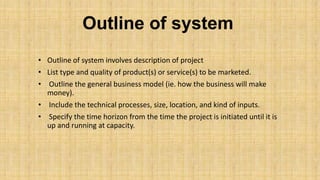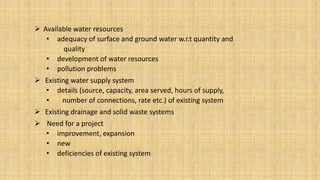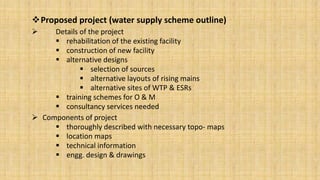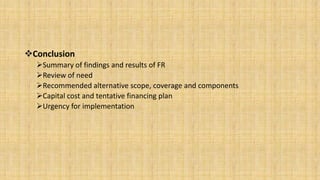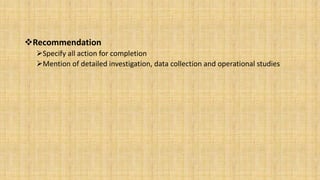Feasibility report -basic concepts with example
- 1. Feasibility Report By SHRINIVAS B. KOREWAR (ROLL NO:5) ABHIJEET B. BHOSALE(ROLL NO:14)
- 2. What is feasibility study? • A feasibility study is an analysis of the viability of an idea through a disciplined and documented process of thinking through the idea from its logical beginning to its logical end. • Feasibility study is carried out in order to assess the viability of a new project • It is primary and most important thing in development of a project
- 3. Reasons to Do a Study • Gives focus to the project. • Narrows the business alternatives. • Identifies new opportunities. • Identifies reasons not to proceed. • Provides valuable information for “go/no go” decision. • Increases probability of business success by identifying weaknesses early. • Provides documentation that the idea was thoroughly investigated.
- 4. Types of feasibility • Operational feasibility 1. Useful for identifying operational problems to be solved, and their urgency 2. The “PIECES” framework P-Performance ,I-Information, E-economy , C-control E-efficiency ,I-Information, S-services
- 5. Types of feasibility • Market Feasibility 1. 2. 3. 4. 5. Determine facility needs. Suitability of production technology. Availability and suitable of site. Raw materials. Other inputs
- 6. Types of feasibility • 1. 2. 3. Financial/Economic Feasibility Estimate the total capital requirements. Estimate equity and credit needs. Budget expected costs and returns • Organizational/Managerial Feasibility 1. Business Structure 2. Business Founders • Environmental feasibility Environmental impact and their assessment
- 7. Types of feasibility • Legal feasibility 1. Is the project legally feasible? 2. Legal requirements.
- 8. Feasibility report • A feasibility report is the results of a feasibility study. This report details whether or not a project should be undertaken and the reasons for that decision. • Report Content 1. 2. 3. 4. 5. 6. 7. Introduction/Executive Summary Background outline of project Methodology/method of analysis Overview of alternatives Conclusion Recommendation
- 9. Introduction/Executive summary 1. It state objective of the report and of the project 2. It should refer terms of references 3. Also it should state the constraints within which it has been conducted 4. Executive summary: This should concise summary of the major recommendations of the report within 6 pages so that it quickly understood by senior executive
- 10. Background • Some feasibility reports may require some background discussion in order to make the rest of the report meaningful to readers. • Describe your proposed plan in sufficient detail state if it worked elsewhere and how it was implemented • Background on the Situation. For many feasibility reports, you'll need to discuss the problem, need, or opportunity that has brought about this report.
- 11. Outline of system • Outline of system involves description of project • List type and quality of product(s) or service(s) to be marketed. • Outline the general business model (ie. how the business will make money). • Include the technical processes, size, location, and kind of inputs. • Specify the time horizon from the time the project is initiated until it is up and running at capacity.
- 12. Methodology • It involves discussion on method of analysis for feasibility study • Return on Investment (ROI) analysis For comparing overall profitability ROI = Estimated lifetime benefits - Estimated lifetime costs Estimated lifetime costs or ROI = Net Present value / Estimated lifetime costs
- 13. SWOT Analysis :STRENGTHS WEAKNESS MAINTAINING THESE STREGTHS OVERCOMING THESE WEAKNESS What can do for maintain these strengths? What should I do to overcome these weakness? OPPORTUNITIES THREATS TAKING ADVANTAGE OF THESE OPPORTUNITIES OVERCOMING THREATS What can I do to take the advantage of these opportunities? What can i do to overcome these threats?
- 14. Overview of alternatives • Possible alternatives • “Sticking with the current system” should always be studied as one alternative • Different business processes for solving the problems • Different levels/types of computerization for the solutions • Advantages and disadvantages of the alternatives • The major possible alternatives should be discussed and compared using clearly defined criteria.
- 15. 1. Estimate Equity and Credit Needs • Identify alternative equity sources and capital availability Producers, Local Investors, Angel Investors, Venture Capitalists • Identify and assess alternative credit sources. Banks, Government (direct loans or loan guarantees), Grants, Local and State Economic Development Incentives. • Assess expected financing needs and alternative sources. Interest Rates, Terms, Conditions, Etc.
- 16. 2. Cost and benefits evaluation • It demonstrate how this proposal is feasible • It involves discussion technological feasibility, economic practicality, social desirability, and ecological soundness • 1. 2. 3. 4. 5. 6. Examples of benefits cost reductions error reductions increased throughput increased flexibility of operation improved operation better (e.g., more accurate) and more timely information.
- 17. • Types of costs Development costs purchasing cost, Installation cost, operational cost
- 18. Conclusion • The conclusions section of a feasibility is the restatement of the conclusions you have already reached in the comparison sections. In this section, you restate the individual conclusions, for example, which model had the best price, which had the best battery function, and so on. • It must untangle all the conflicting conclusions and somehow reach the final conclusion, which is the one that states which is the best choice
- 19. Recommendation • The final section of feasibility reports states the recommendation. • The recommendation section should echo the most important conclusions leading to the recommendation and then state the recommendation emphatically. • the basis for that judgment has to be stated somewhere in the requirements section.
- 22. Example of feasibility report on Waste water system
- 23. Feasibility Report Executive Summary Includes principal / salient features of technical, financial and administrative aspects of the project Introduction project genesis – how idea of project originated? - whether fits in development plan? organization of study scope and status of report
- 24. Project area and need for the project(background) Project area geographic, topographic, climatic, religious, cultural descriptions Population pattern estimation and analyze growth rate estimate probable density of population Economic and Social conditions present living standards of various groups identification of locations according to income levels housing conditions data on education, literacy, unemployment etc.
- 25. Available water resources • adequacy of surface and ground water w.r.t quantity and quality • development of water resources • pollution problems Existing water supply system • details (source, capacity, area served, hours of supply, • number of connections, rate etc.) of existing system Existing drainage and solid waste systems Need for a project • improvement, expansion • new • deficiencies of existing system
- 26. Proposed project (water supply scheme outline) Details of the project rehabilitation of the existing facility construction of new facility alternative designs selection of sources alternative layouts of rising mains alternative sites of WTP & ESRs training schemes for O & M consultancy services needed Components of project thoroughly described with necessary topo- maps location maps technical information engg. design & drawings
- 27. Implementation schedule (CPM/PERT) Cost Estimates capital investment (for all components) recurring cost (annual) Impact on the environment Institutional responsibilities (Identification of organizations) approval funding implementation O&M
- 28. Financial plan Source of fund Interest on loan Recurring expenses Annual burden
- 29. Conclusion Summary of findings and results of FR Review of need Recommended alternative scope, coverage and components Capital cost and tentative financing plan Urgency for implementation
- 30. Recommendation Specify all action for completion Mention of detailed investigation, data collection and operational studies
Editor's Notes
- feasible means possible or viable5
- technically financially socially legally environmentally institutionally
- 1.P-Performance E-efficiency I-Information S-servicesE-economyC-control2.Determine facility needs.Suitability of production technology.Availability and suitable of site.Raw materials.Other inputs.. Market Industry description. Industry competitiveness.Market potentialAccess to market outlets. Sales projection
- Are there any legal requirements or issues we need to look at or attend to?Do we need a special shareholders agreement?What warranties will be required?Can we afford to meet these warranty obligations?Will we need to address any Trade Practices Act requirements?Are there any special insurance requirements?Are there any special licences we need to look at or obtain?Do we require any special contracts or is there a need to raise anycontracts or contractual issues?
- In feasibility report the headings may differ but overall content will be same
- for example, a discussion of power and speed of laptop computers is going to necessitate some discussion of RAM, megahertz, and processors.
- Solution with the highest ROI is the best alternative - But need to know payback period too to get the full picture - E.g. A lower ROI with earlier payback may be preferable in some circumstances
- If possible numerical weighting for each criteria should beestabilished
- Examples of benefits cost reductionserror reductionsincreased throughputincreased flexibility of operationimproved operationbetter (e.g., more accurate) and more timely information.Types of cost Development costs purchasing cost, Installation cost, oprerational cost
- Now let us see example on feasibility report, we will discuss example on project of installation of water supply line











